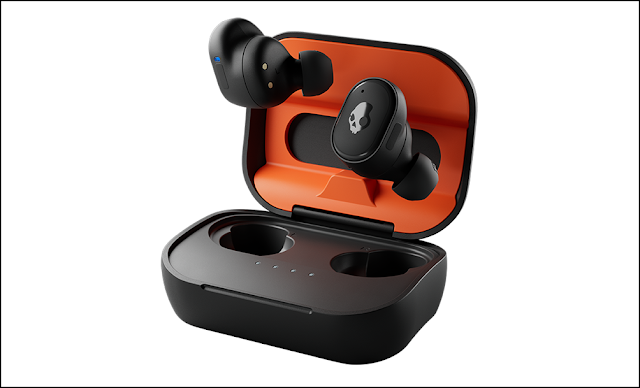Earphones with a Large Battery
The Grind Fuel earbuds (in black) are composed of plastic and have a strong feel about them. The earpieces are a little heavy, but that helps them stay in your ear, and there are three sets of silicone eartips in small, medium, and large sizes. The frequency response of 12mm dynamic speakers is 20Hz to 20kHz on the inside.
The Skullcandy app allows you to operate the earpieces with your voice or using buttons (we discuss voice controls in the next section). A single push begins playback, a double press changes volume (down on the left ear and up on the right), and a press-and-hold initiates Spotify. A prolonged press-and-hold sends audio to other Skullcandy Skull-iQ-enabled items.
The earpieces have an IP55 rating, which means they're dust-resistant and can tolerate mild splashes and low-pressure sprays from any angle. Wearing them after a sweaty workout or in the rain isn't a problem, but you shouldn't clean them by washing them under the tap or immersing them in water. The casing isn't water proof, so make sure the earpieces are totally dry before docking them for charge.
The provided (but very short) USB-C-to-USB-A charging cable plugs into a USB-C connector on the case's back panel. The charging stations, as well as internal monitoring LEDs that show how much power is left in the case, are revealed by a flip-top cover.
The earpieces' battery life is estimated to be around 9 hours by Skullcandy. The charging case is big (and gets significantly warm when charging), but it provides an extra 31 hours of battery life. These are both good statistics for genuine wireless in-ears, however bear in mind that your results may vary depending on your volume settings.
The earbuds are Bluetooth 5.0 compliant and support the SBC Bluetooth codec, however they do not support AAC or AptX. If you want to transmit high-fidelity audio, this restricted codec support isn't suitable.
Voice and App Features
The Skullcandy app (available for Android and iOS) offers a Tile-linked Find My Earbuds function, as well as configurable EQ and earpiece settings (you may allow rapid access to Spotify and/or remote control for your phone's camera). Stay Aware mode allows you to hear what's going on around you.
The voice controls may be another motivation to download the programme. If you use Spotify, for example, you can play music by saying, "Hey Skullcandy, Spotify." You may still utilise voice commands for basic playback controls if Spotify isn't your preferred music player. However, because they require the Skullcandy app to be open, this voice connection isn't really useful.
Bass-oriented
The Grind Fuel earbuds give tremendous low-frequency response on tracks with significant sub-bass content, such as The Knife's "Silent Shout." The drivers do not distort at high, inappropriate listening levels, and the bass remains deep and powerful at lower volumes.
"Drover," a tune by Bill Callahan with significantly less deep bass in the mix, giving us a clearer understanding of the Grind Fuel's sound characteristic. The percussion on this song are strong and nearly thunderous, while Callahan's baritone vocals have a lot of low-frequency depth. The acoustic strums and higher-register percussion impacts should have a little more high-mid and high-frequency presence than they do here; the mix isn't muffled, but it lacks a touch of brightness and treble edge in places. With the EQ, you can correct that flaw.
The kick drum loop on Jay-Z and Kanye West's "No Church in the Wild" gets enough high-mid presence to keep its punchiness, but the beefed-up low-end of the drum loop jumps out here. The highs are amplified to the point that we can hear more vinyl crackle and hiss in the background than usual, but this doesn't appear to extend to the high-mids. The sub-bass synth bursts that interrupt the beat have a lot of depth and strength, giving the bass a subwoofer-like feel. The voices are clear, however a little more high-mid presence would improve the sonic signature significantly.
Orchestral pieces, such as the opening scene from John Adams' The Gospel According to the Other Mary, are well-balanced. The lows aren't overemphasised, and the brass, strings, and vocals have enough brightness and high-mid presence to avoid sounding flat.
Using the Voice Memos app on an iPhone, we tested the built-in mic and were able to comprehend every word we recorded. Although there are signs of usual Bluetooth audio distortions, the signal is still robust. Callers should be able to comprehend you over a strong connection.
It Wasn't Worth It
The Skullcandy Grind Fuel earbuds offer a lengthy battery life and a respectable sound (despite only supporting the SBC Bluetooth coding), however neither of these features helps them stand out in a crowded market. The aforementioned Anker Soundcore Life P3 and the $80 Jabra Elite 3 are our favourites in the sub-$100 pricing bracket. The Push Active in-ears from Skullcandy are less expensive and perform similarly. If you're prepared to pay a little more, Anker's $129.99 Soundcore Liberty Air 2 Pro earbuds provide the finest noise cancelling under $150.




0 Comments